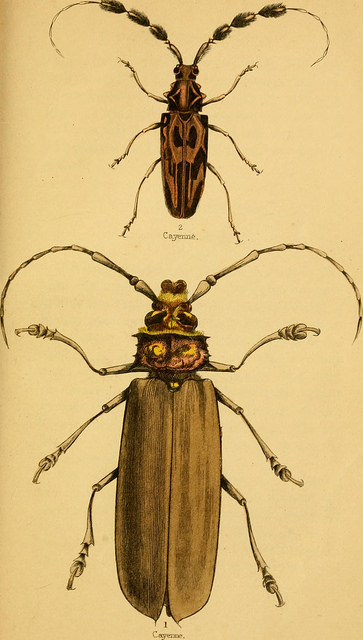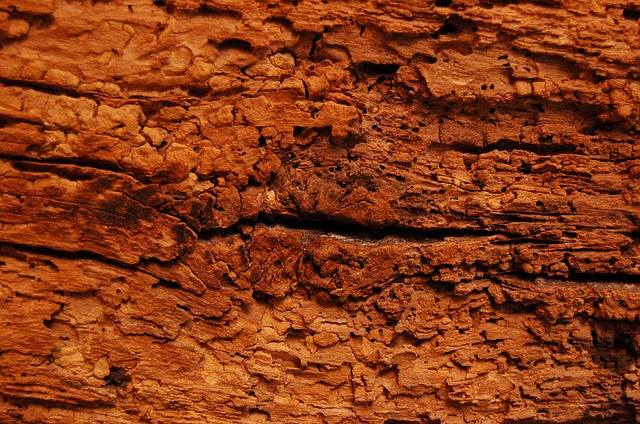
In order to be able to tell if you have an active woodworm infestation, you need to know about woodworms and their life cycle. Why? Because you’ll understand better why it is important to catch an infestation on time before too much damage is done to your home.
What Are Woodworms?

Woodworm is the common name for the wood-eating larvae of beetles, four types of which can be found in the UK. They lay their eggs inside a piece of wood (floorboard, furniture) or timber.
There are differences between the four major types, for example, the Common furniture beetle is no more than 4.5mm in length and is brownish in colour, whereas the Deathwatch beetle can get up to 11mm in length, also brownish in colour.
Where are woodworms likely to appear? Some are most likely to lay their eggs on your roof timber, some (like the Deathwatch beetle) prefer damp wood where wood decay has already begun. They can also have laid their eggs in the crevices of antique furniture, the floorboards of your basement. Keep in mind that second-hand or vintage furniture has the potential to become infested, even if they have been treated once.
Woodworm Lifecycle, Damage and How to Tell if it's Active
An infestation can be happening right in front of your eyes and you will not know it. So, here is what you should know about the stages of the woodworm and what makes an infestation active:
All woodworms have the same four stages of development.
1. First, the female beetle lays its eggs in the crevices or in already existing holes in your wooden floorboards, antique furniture, or the sapwood of the roof.
2. The second stage is the larva. When the larvae hatch from the eggs they tend to burrow even deeper into the wood remaining hidden from your sight. This stage can continue for years, with the larvae tunnelling and feeding off the wood. The larvae are the actual danger here, so when you do notice the signs of infestation act quickly.
3. The third stage is the pupa. After the time when the larvae are feeding, they grow in size and become known as a pupa. This is the longest process- between 2 and 5 years and is the last stage before the beetle emerges.
4. The final stage is the adult beetle. Which not only eat its way out of the wood, leaving a distinct trace behind but will even do something worse - reproduce. Which will start the entire process again.
How to Spot Signs of Active Woodworms
Woodworm infestation is hard to notice but here are some signs to look for:
>>> Fresh sawdust around the holes. When the larvae are eating up the wood, sawdust is very likely to appear near the fresh holes. A simple way to check for an active woodworm problem is to clean the area around your furniture/roof timber/floorboards well and keep track if new frass or sawdust appear near the holes.
>>> If possible, mark the existing holes and after some time (a week or two) check to see if there are new ones.
>>> Do holes look differently? Do some look older than others?
>>> Are there weird sounds, dead larvae or beetles near wooden surfaces. An even clearer sign of activity is seeing a beetle fly out of the wood.
>>> Tunnels in the wood. The Longhorn beetle can leave tunnelling marks on your furniture.
The different types of woodworms are attracted to all kind of wood and timber. Do not think that you are safe from a woodworm infestation. They can lay eggs in softwoods, hardwoods, a variety of timbers, plywood, seasoned or freshly cut up wood, and in old or new furniture.
There is also a correlation between a damp wood (or wood that is in damp place) and the active woodworm infestation. If your furniture, roof timber, or floorboards are kept in a damp place, they have a higher chance of being infested.
How to Prevent Woodworm Damage
 The damage that the active woodworm can inflict if left untreated is the decay of your wood and timber. And not to forget the unsightly look.
The damage that the active woodworm can inflict if left untreated is the decay of your wood and timber. And not to forget the unsightly look.
The damage they can do depends on how long the woodworms have been active and if there is damp in the wood.
>>> Replace the infested piece of wood to protect your home. Removing the infested piece of wood (if it is a piece of furniture) will prevent damage to other wooden materials.
>>> Keep your home dry and well-ventilated - some species of beetles are attracted to the dampness of the wood and it even helps them reproduce faster. So, make sure all of your wooden furniture, roofing or flooring do not get damp.
>>> Buy ultraviolet insect killers - to keep woodworms and other bugs away from your home.
>>> Depending on the type of beetle you can try some DIY methods to fight the woodworms on your own.
>>> Hiring professional help for inspection and woodworm treatment will most likely ensure the safety of your furniture and home.
Keep an eye out for the above-listed signs - sawdust, frass, new holes, scratching sound. No wooden object is safe from woodworms unless it was treated by experts.
In case your method is not efficient and you keep seeing signs of woodworms’ activity, turn to professional woodworm treatment before it is too late. If you have doubts get a professional inspection. The treatment of woodworm infestation is with special insecticides and kills the woodworms in all stages.






